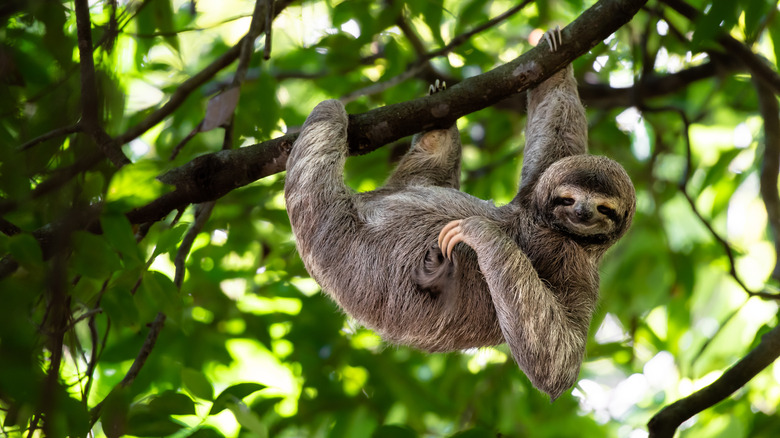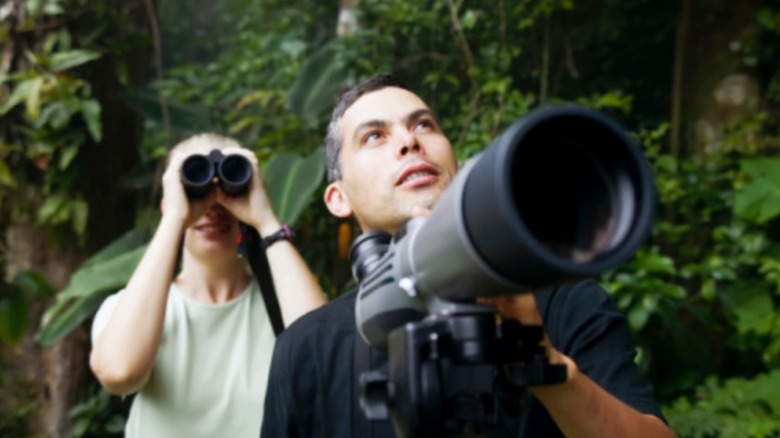The Biggest Complaint Many Tourists Have After A Trip To Costa Rica
From beachside sunsets to fresh coffee on a crisp morning beneath Arenal Volcano, there's nothing quite like a Costa Rican vacation. Folks flock to the land of pura vida to escape the bustle of the day-to-day or sometimes for something completely different — sloths. Costa Rica is known for these cuddly-looking critters, so it only makes sense that travelers want to see them during their trip. After all, you see them plastered on practically every kind of gift at the gift shops in Costa Rica. Going sloth spotting is definitely one of the most amazing things to Do in Costa Rica.
What may surprise you is that sloths don't just call Costa Rica home. While the two are synonymous, sloths can be found all over South and Central America. For example, they can be seen in Peru, Honduras, Ecuador, and Colombia. Sadly, their numbers are also falling because they only have babies every three years and are dying faster than they are reproducing. Deforestation is taking a huge toll on the two species of sloth who live in Costa Rica.
Despite that, travelers may be annoyed if they don't see a sloth while they're in Costa Rica. Although these slow-moving mammals aren't spotted as often as squirrel monkeys or coatimundi, you can find them if you know where and how to look.
Understand where the sloths are
While the sights of the capital city of San José may appeal to human visitors, they aren't appreciated by sloths. That's partly why travelers to Costa Rica who hope to simply bump into a sloth while walking around are frustrated that they didn't. There are several reasons for that, but mainly sloths spend 99% of their time hanging out in tree canopies in the rainforest. Sloths only come down once a week to do their business — because they know better than to do it while hanging upside down.
The best way to nearly guarantee seeing a sloth is to travel to wherever they are. That means venturing into the moisture-dense rainforests in areas like La Fortuna, Tortuguero, Monteverde, and Puerto Viejo, to name a few. Many of the sloth-friendly areas are also the best destinations for a little bit of everything in Costa Rica. Manuel Antonio National Park is a particular favorite in addition to local sloth sanctuaries.
Whether or not you see a sloth in Costa Rica also depends on when you visit. Although you can spot them year-round, they do (like many other rainforest dwellers) prefer the rainier times of the year. What is imperfect travel weather for humans is preferred for sloths. Keep in mind, too, that they are also largely nocturnal. So, even though you want to score those full-color photos of these cutie pies, and they're easier to spot when they're sleeping, you probably won't get much of a show during the day.
Better your chances of spotting sloths and get a guide
Even if you're prepped for a Costa Rican adventure with all the knowledge you need, you may still not see a sloth. Your best bet is to hire a guide to accompany you through the rainforest trails. These guides are skilled at wildlife spotting and familiar enough with the areas to know where the sloths usually are.
Unless you get very lucky, any sloths you spot may not appear to the naked eye as more than just a fuzzy (and sometimes mossy) lump in a high-up canopy. So, it's easy to miss them if you aren't with someone who knows. You might even spot a mama and baby sloth snuggling the day away! What could be better for a family vacation in Costa Rica?
Be sure to ask your guide if they have a telescope, too. These will help you see far-away sloths closer up. They should also be able to help you get some photos through the telescope with your phone or camera, which is also a neat trick. You'd be surprised how few other visitors will hire a guide. When you're walking the trails and seeing annoyed travelers, disappointed they couldn't spot a single sloth in the canopies, you'll be glad you brought an expert.


